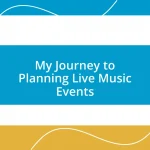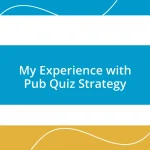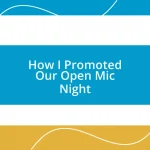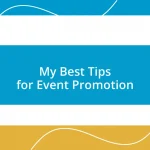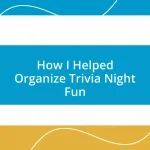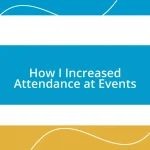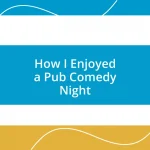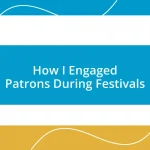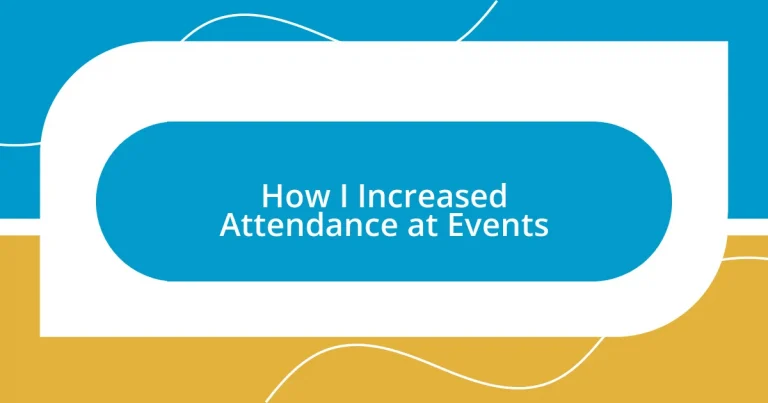Key takeaways:
- Attendance fosters connections and enriches event experiences through diverse perspectives and emotional investment.
- Identifying your target audience through demographics, interests, and feedback is crucial for tailoring events to their needs.
- Engaging content, effective social media use, and strong partnerships significantly enhance event visibility and attendance.
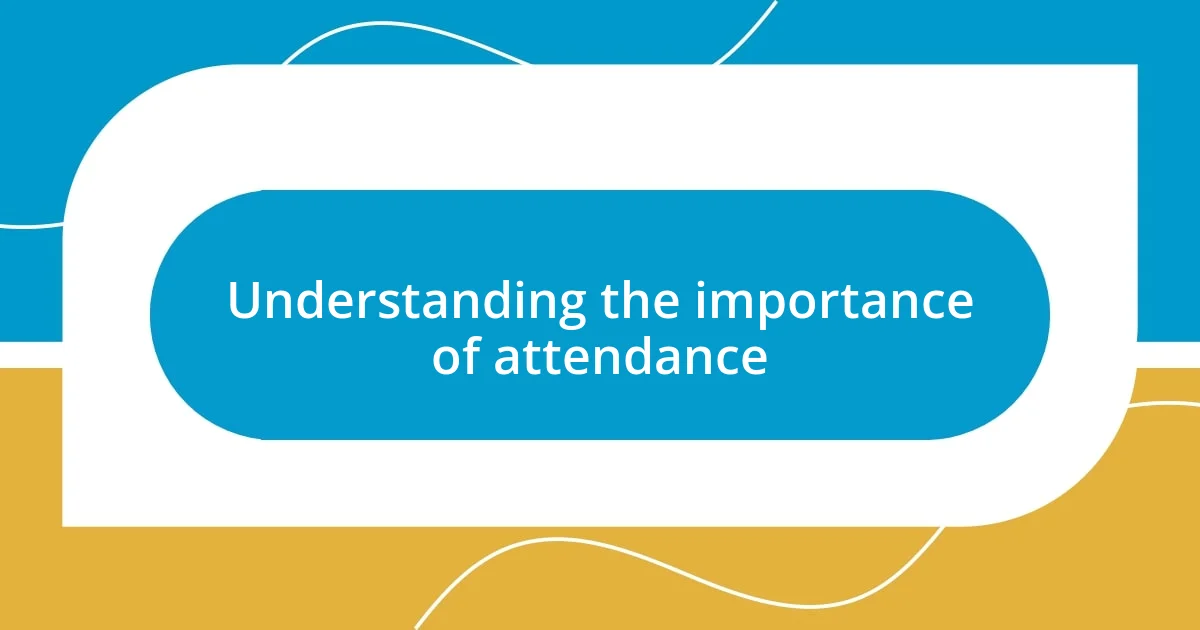
Understanding the importance of attendance
Attendance is more than just numbers; it’s about connection. I remember one event where the energy in the room shifted as more attendees arrived. Their enthusiasm transformed a simple gathering into a vibrant community. Can you recall a time when the presence of others completely changed an event’s atmosphere for you?
When people show up, they’re participating in a shared journey. I once hosted a workshop where the turnout exceeded my expectations. It was incredible to witness diverse perspectives blending together, sparking creativity and collaboration. Have you ever felt that magic when everyone contributes their voice?
Moreover, the emotional investment of attendees plays a critical role in the success of any event. Each person brings unique stories, and I’ve noticed how these narratives enrich discussions and foster deeper connections among attendees. Isn’t it amazing how one presence can ignite inspiration and motivate others to engage more fully?
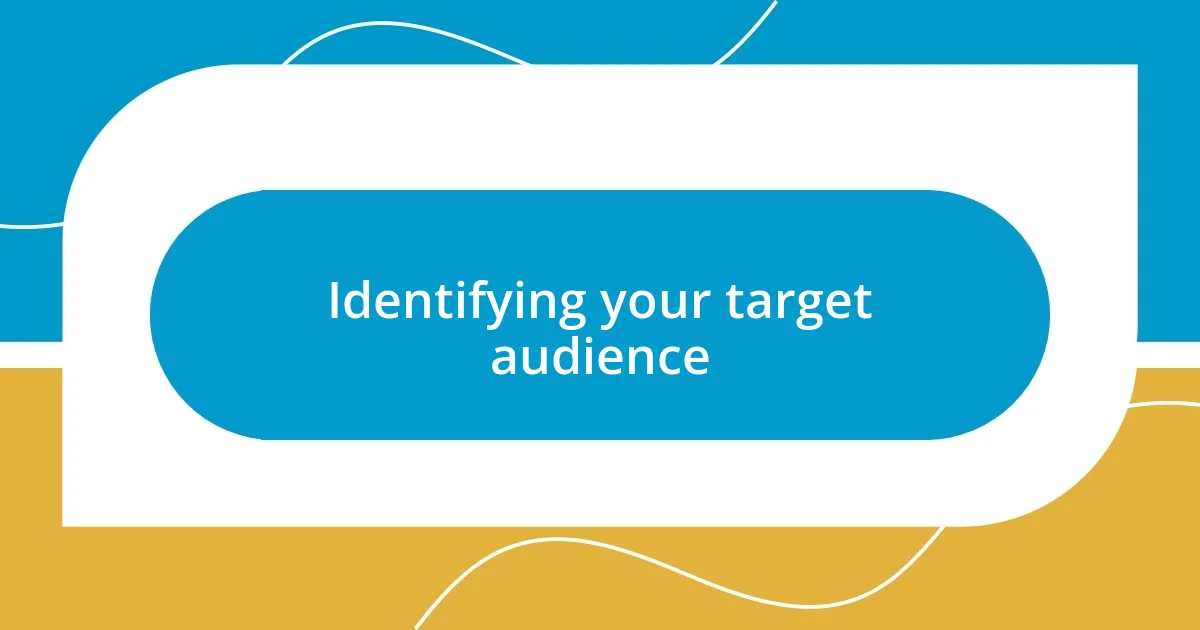
Identifying your target audience
Understanding who your target audience is can make all the difference. I recall a community festival I organized where I thought everyone would love the same activities. However, I quickly learned that not all demographics found the same games appealing. It’s essential to dive deep into understanding what your audience truly values and enjoys.
To effectively identify your target audience, consider the following points:
– Demographics: Age, gender, occupation, and location significantly influence interests.
– Interests: Explore hobbies and passions that resonate with your potential attendees.
– Pain Points: Understand the challenges your audience faces and how your event can provide solutions.
– Feedback: Engage with past participants to gather insights on what they liked or felt was missing.
– Social Media Analytics: Analyze the data from your platforms to gauge the interests and behaviors of your followers.
By focusing on these elements, you not only cultivate a clearer picture of who to reach but can also tailor your events to better resonate with their needs and desires.
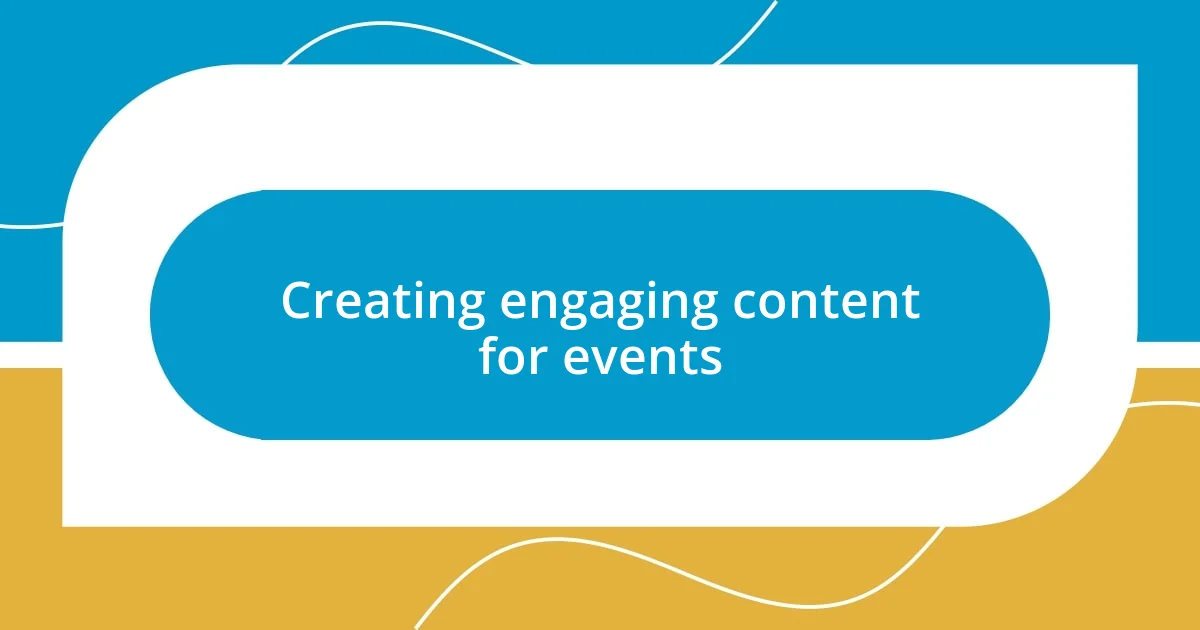
Creating engaging content for events
Creating engaging content for events is crucial for capturing attention and sustaining interest. I’ve found that storytelling can be a powerful tool; for instance, at my last workshop, I shared a personal experience about overcoming a challenge. It wasn’t just about the information; the audience connected with my vulnerability, and I saw their eyes light up with recognition. Has a story ever resonated with you so deeply that you felt compelled to engage further?
Furthermore, interactive elements can elevate an event’s engagement level. I remember a panel discussion where we incorporated live polls, allowing attendees to voice their opinions in real-time. This instantly created buzz, making everyone feel like contributors rather than passive listeners. Wouldn’t it be great to harness such tools to create an inclusive atmosphere?
Lastly, incorporating multimedia content—like videos or podcasts—can enhance the event experience. At an educational seminar I hosted, I used a short video that highlighted participant success stories, which really struck a chord with everyone. The emotional responses I witnessed demonstrated how impactful it can be when attendees see themselves reflected in the content. Have you ever felt a surge of motivation when exposed to inspiring stories?
| Engagement Methods | Description |
|---|---|
| Storytelling | Sharing personal stories that resonate emotionally, fostering connection. |
| Interactive Elements | Using live polls or Q&A to encourage attendee participation. |
| Multimedia Content | Incorporating videos or podcasts to illustrate key points and engage senses. |
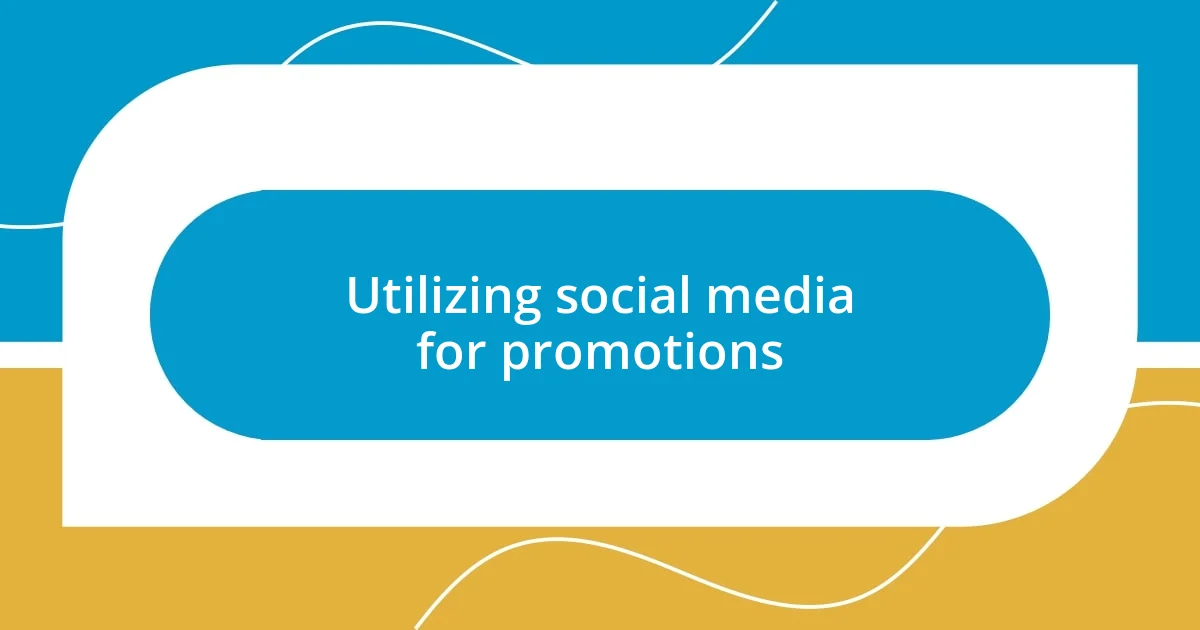
Utilizing social media for promotions
Utilizing social media for promotions can be a game-changer for increasing attendance at events. I remember when I launched a local art exhibition; I turned to Instagram to share sneak peeks of the artwork. This not only sparked curiosity but also allowed people to connect with the artists through stories and comments. Have you ever thought about how a simple post can turn a casual viewer into an eager attendee?
Making sure to engage with your audience on these platforms is crucial. I often reply to comments or ask questions in my posts, which creates a dialogue and fosters a sense of community. One time, I hosted a giveaway for free tickets to an event, and the shares and comments skyrocketed. It was a true testament to how social media can amplify your reach when you actually converse with your followers instead of just broadcasting messages.
Additionally, employing targeted ads can really maximize your promotional efforts. I tried this with a charity gala, specifically targeting local users who expressed interest in similar causes. The results were astounding—attendance far exceeded expectations, and I couldn’t help but feel that we made a genuine impact. Isn’t it rewarding to use tools that connect directly with your potential audience?
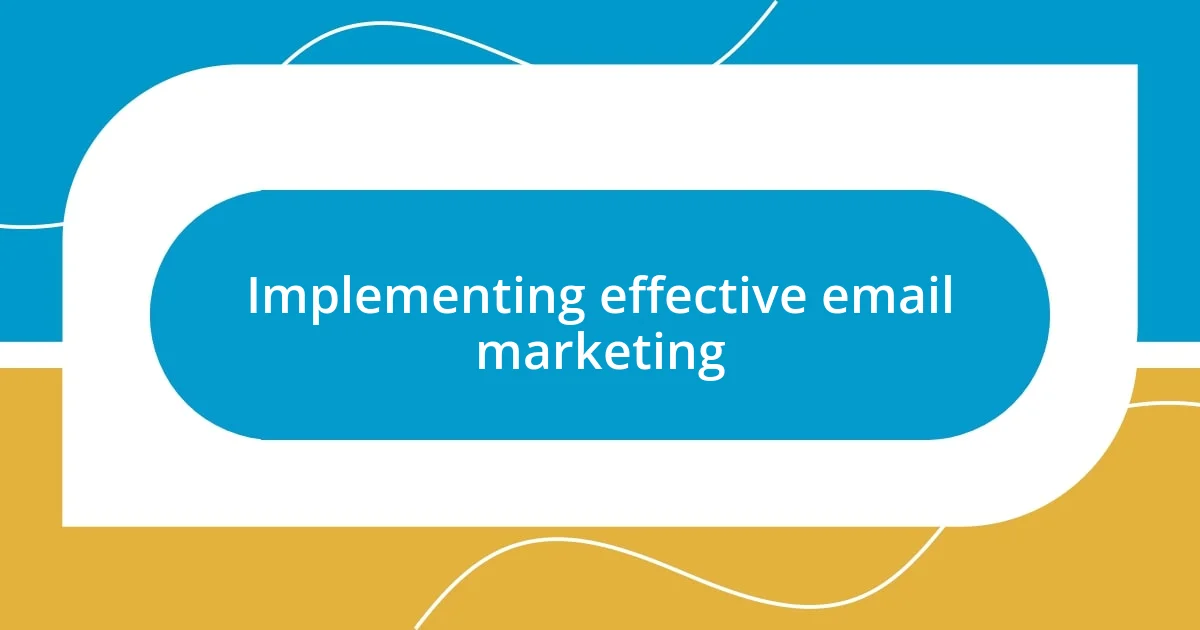
Implementing effective email marketing
Implementing effective email marketing can truly transform event attendance, and I’ve seen it firsthand. When I launched a recent conference, I crafted personalized emails that felt more like a conversation than a broadcast. Instead of just listing details, I shared a brief story about what attendees could gain from joining, which sparked genuine interest. Have you ever received an email that felt tailored just for you? It makes a world of difference.
I also discovered the power of segmentation. By categorizing my email list based on past attendance and interests, I tailored messages that resonated with specific groups. For instance, I sent exclusive early-bird offers to loyal attendees who had come to previous events. The response was overwhelming, and I found that people appreciate being recognized and rewarded for their loyalty. Have you noticed how being part of an exclusive group can make you feel special?
Incorporating visuals into my email campaigns has also been incredibly effective. During a recent webinar promotion, I used eye-catching images along with short video teasers from previous events. This not only grabbed attention but also conveyed the energy and excitement of what attendees could expect. I still remember the delightful surprise of seeing my open rates soar—it’s exhilarating when you realize that your message has struck a chord. What elements have you found to be the most engaging in your email communications?
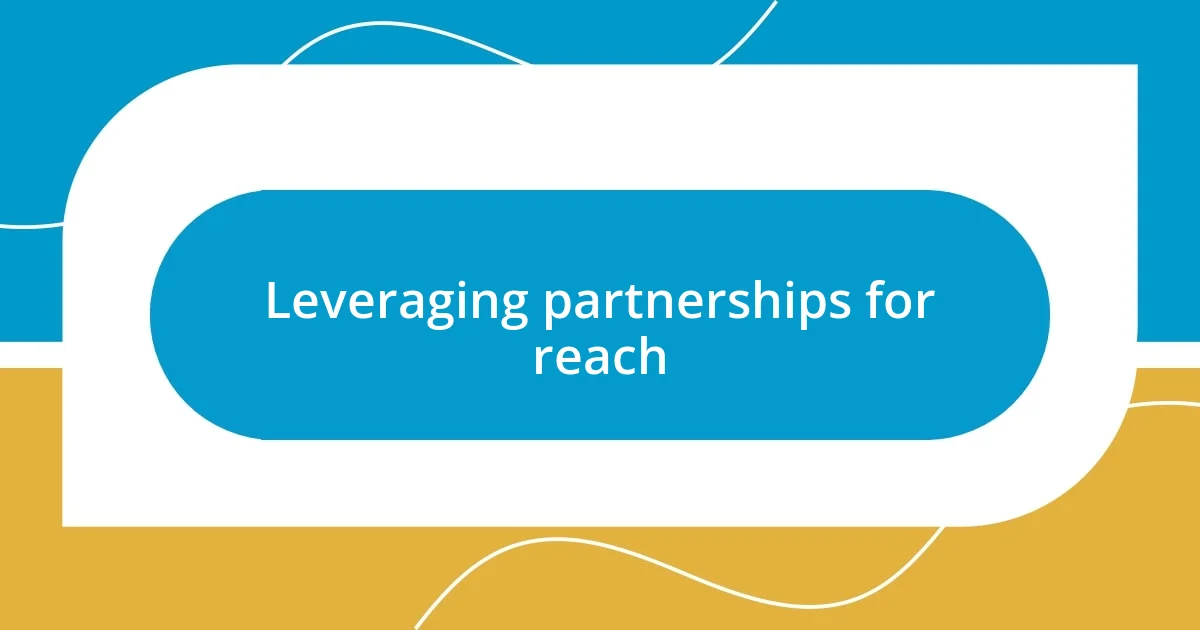
Leveraging partnerships for reach
Building strong partnerships can significantly broaden your event’s reach. For example, when I collaborated with a local university for a career fair, we tapped into their student base, which instantly expanded our audience. I found that by aligning our goals, we not only drew in more attendees but also created a buzz on campus that drove interest. Have you ever partnered with an organization that brought a fresh audience to one of your events?
One of my favorite experiences was joining forces with a nearby nonprofit for a fundraising concert. Through their established network, we attracted donors and supporters who might not have heard about our event otherwise. It was incredible to see how sharing resources and marketing channels could yield a mutual benefit. When was the last time you reached out to an organization for collaboration that led to unexpected success?
In another instance, I partnered with a local influencer who had a genuine passion for our event theme. Their personal endorsement not only increased our visibility but also lent credibility to our cause. I can still recall the excitement in my community when they shared our details—people were talking about it for weeks! Have you ever thought about how a decentralized approach can enhance your event’s reach through trusted voices?
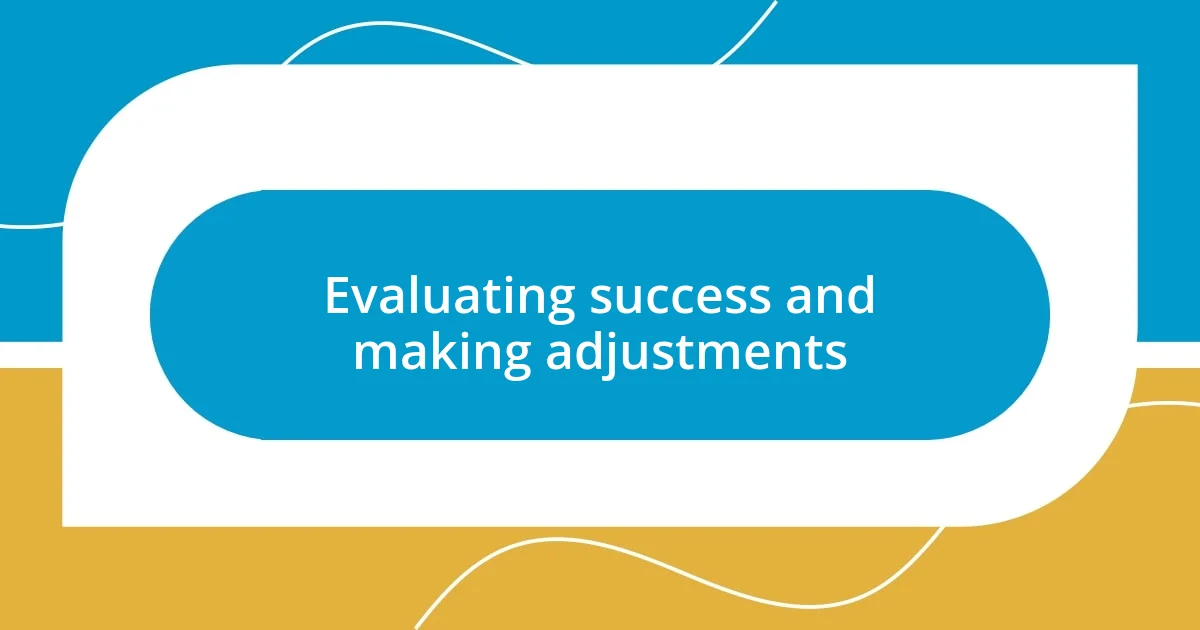
Evaluating success and making adjustments
Evaluating the success of an event is just as critical as planning it. After my latest seminar, I gathered feedback from attendees not only through surveys but also via casual conversations. Listening to their insights helped me identify what worked well and what didn’t. Have you ever felt a twinge of regret after not asking attendees how it went? I learned that these real-time insights are gold for future improvements.
I often use attendance numbers as a baseline, but they don’t tell the whole story. I remember when we had high numbers at one event, but the engagement during the sessions was lackluster. By analyzing social media interactions and post-event discussions, I found that the content didn’t resonate as well as intended. This taught me that metrics should go beyond headcount; they must reflect the quality of the experience. What metrics do you prioritize when gauging event success?
Making adjustments is a continuous process that cannot be overlooked. After recognizing a dip in post-event attendance, I decided to implement quarterly networking gatherings. This not only kept the community engaged but also created anticipation for future events. I still relish the excitement on attendees’ faces—the “Aha!” moments when they realize the real value of ongoing connections. Have you considered how small tweaks can lead to a larger impact on your event community?

